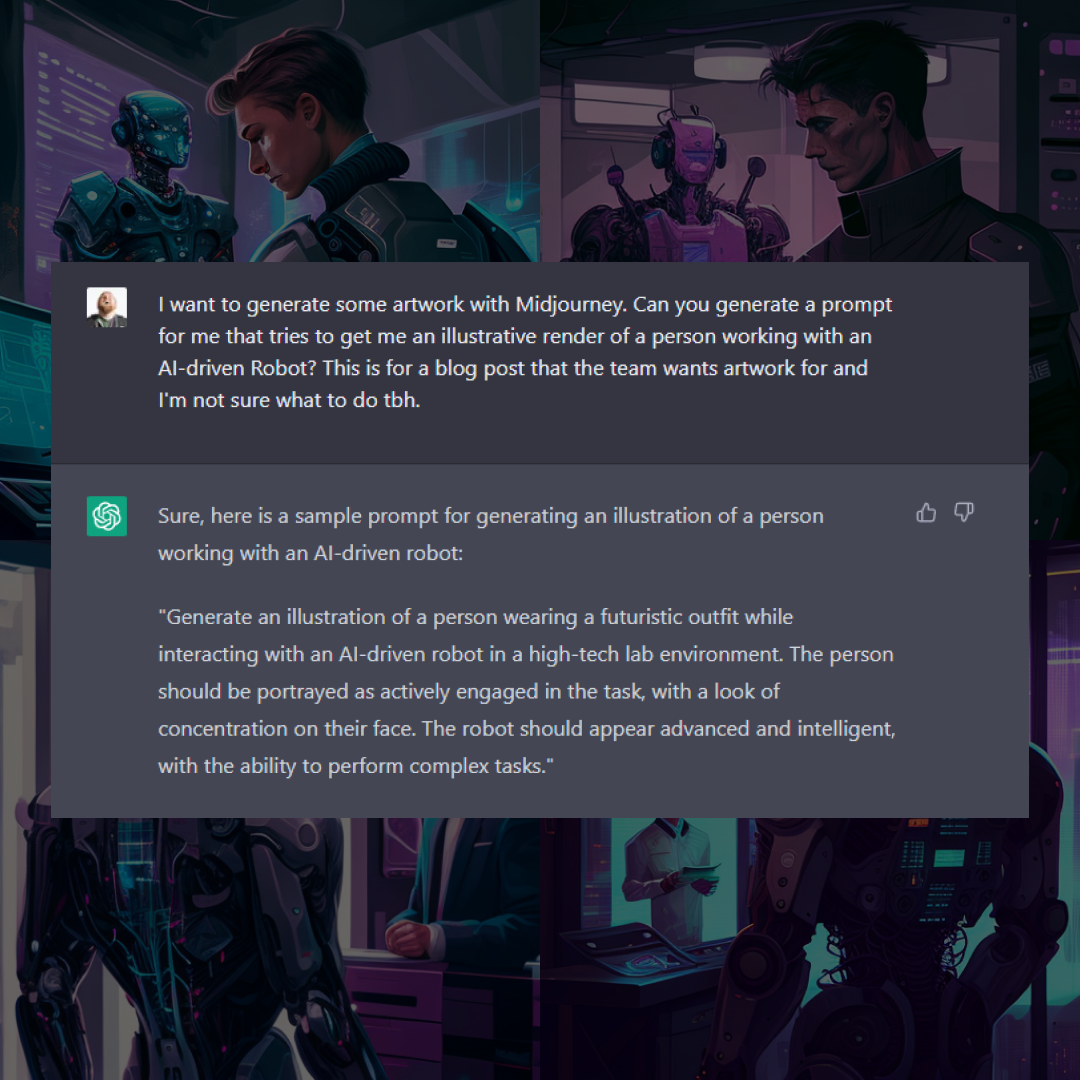
AI Isn’t the Robot Butler You Think It Is

If I say “AI,” what’s the first thing that pops into your head? J.A.R.V.I.S. from Iron Man? Well, you’d be right. But unless you’re a genius billionaire like Tony Stark, AI refers to the tools everyday people use in the workplace. Some folks love the productivity promoted by these robot butlers—and others are foaming at the mouth (peep the comment section of blogs about AI; they are blowing up with accusations of stealing intellectual property).

I interviewed three individuals who have grown with the industry, who have used AI on various projects (both technical and creative, and who might just have more combined knowledge than J.A.R.V.I.S. himself): our COO, Kevin Jones; one of our creative directors, Jenna Hubert; and one of our technical directors, Nitish Narala.
Their hot takes:
- AI has been used for years, but it's only now people are freaking out about it.
- AI should only be used as a jumping off point.
- AI will create as much opportunity as it replaces—if not more.
Like any new technology, the initial idea of AI seems scary as it’s often viewed as a substitute for human creativity versus a catalyst for it. People worried jobs would disappear with the arrival of cameras. Instead, jobs changed to fit the ever-evolving landscape of art. Agency life is no different.
Putting the “AI” in “mainstream”
What people frequently forget is that AI already touches many parts of our lives. Do you have Grammarly installed on your browser of choice? AI. Like to add filters on social media to turn that frown upside down? AI. Ever use Spotify’s auto-generated playlists? AI.
In fact, any time you hear the word ‘algorithm’, you can think of that as a foundation for AI. Jenna says that, “with Midjourney and ChatGPT being free platforms, we've all gotten to see in a more tangible way how algorithms can be put into action.”
What all the hip agencies are using
And, by that, we mean KPS3 (hello, insider knowledge). Aside from extensions like Grammarly, here are the top three AI technologies we’re using:
- ChatGPT (also known as an AI that got Kevin so excited that he decided to use an interaction with it as our company’s internal holiday cards) is helpful for copywriting and brainstorming initial ideas for concepts. Need a jumpstart on 40 headlines to get in the zone? Easy peasy. Now you can spend the next 30 minutes exploring various pathways instead of the initial 30 minutes Googling.
- GitHub Copilot offers you quick solutions in coding as well as an opportunity to rubber-duck. It considers the past code someone has written and suggests the next set of code, which streamlines the process (regardless of it not always being right, but we’ll get to that).
- Midjourney considers everything that goes into its prompt (design style, the subject, color palette, etc.) to create variations of art, sparking ideas early and with fewer resources.
With all of these tools at our fingertips, it might be easy to say the work is less original or might be taking over jobs. But that’s not true. It’s just that we’ve seen some extreme use-cases, such as doctors diagnosing patients with ChatGPT, that overshadow the tools’ uses for production or helping streamline processes.
One thing everyone I talked to can agree on: AI is best used right now in the creative and technical field as a sounding board—as a “person” to bounce ideas off, to provide new angles not previously considered, and to process information.
Of course, every software has its limitations
While not being able to access ChatGPT for a few hours due to its servers being overwhelmed by the amount of users is limiting for sure, there are other factors to consider when using AI.
“Right now, AI is an emerging field that’s exploding, and that comes with a lot of potential risk. For instance, most AI-platforms reserve the right to use, look, and see all the prompts and items you’re creating. If you handle confidential or sensitive subject matter, these terms of service could be a deal breaker. It’s also important to realize that AI is flawed and not always accurate. AIs have to be trained, and if the information they’re trained on is faulty, the output you get can be faulty.”
AI in general doesn’t have the bigger picture of what a person wants to accomplish with an overall project and, thus, it can’t factor in all of the strategy that’s external to its interaction with a user at that specific moment.When talking with Nitish, he was able to quickly walk me through the GitHub Copilot’s feature as he created a news rollup page. He demonstrated how the software pieced together a contextually accurate solution given instructions, though it missed some syntax and had to be adjusted manually.

Beyond confidentiality challenges and strategic thinking, AI falls short in other aspects:
- ChatGPT used to be able to produce a large amount of copy in one go. Not anymore. (For example, I asked it to create 100 headlines and it came up with 42.) That means AI isn’t reliable since the models are ever-changing.
- ChatGPT struggles when it comes to tone nuances.
- Midjourney and other visual-based AI end up producing very homogenous images that we can tell weren't handcrafted.
- On top of those, a lot of companies have already built tools to identify AI-generated copy and artwork. It's possible social media sites, search engines, and other sites could use that information to negatively impact brands. ChatGPT and other AIs are working on invisible watermarks that can always be used to tell what AI has created it from.
AI has gotten a bad rep of stealing art and intellectual property, though humans have been doing that even longer. Again, AI has to be trained. It’s been programmed on millions of artwork created by real people, making it possible to lean on design styles that took artists decades to perfect. If you use AI to come up with ideas, cool, but give credit where it’s due.

And, while AI gives us the ability to concept creative quickly, we can’t forget it doesn’t replace real people actually developing content. Concept art? Sure thing. Final products with real intent? We still need to find amazing artists to help execute.
TL;DR: AI simplifies tasks in humans’ days; it can’t replace them
One of the things our creative and technical directors loved about AI is using it when they don’t have someone else to talk to (or if their social batteries are depleted).
Whether agencies are on the AI hype train or losing their minds, keep in mind that AI doesn’t offer the creativity and strategic thinking people provide. AI can help optimize a concepting session, but a human still has to bring those ideas to life.